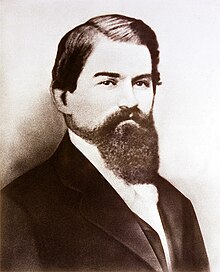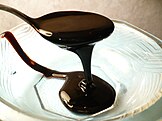Portal:Drink
The Drink Portal
A portal dedicated to all beverages
Introduction

A drink or beverage is a liquid intended for human consumption. In addition to their basic function of satisfying thirst, drinks play important roles in human culture. Common types of drinks include plain drinking water, milk, juice, smoothies and soft drinks. Traditionally warm beverages include coffee, tea, and hot chocolate. Caffeinated drinks that contain the stimulant caffeine have a long history.
In addition, alcoholic drinks such as wine, beer, and liquor, which contain the drug ethanol, have been part of human culture for more than 8,000 years. Non-alcoholic drinks often signify drinks that would normally contain alcohol, such as beer, wine and cocktails, but are made with a sufficiently low concentration of alcohol by volume. The category includes drinks that have undergone an alcohol removal process such as non-alcoholic beers and de-alcoholized wines. (Full article...)
Selected article -
Absinthe was created in the canton of Neuchâtel in Switzerland in the late 18th century by the French doctor Pierre Ordinaire. It rose to great popularity as an alcoholic drink in late 19th- and early 20th-century France, particularly among Parisian artists and writers. The consumption of absinthe was opposed by social conservatives and prohibitionists, partly due to its association with bohemian culture. From Europe and the Americas, notable absinthe drinkers included Ernest Hemingway, James Joyce, Lewis Carroll, Charles Baudelaire, Paul Verlaine, Arthur Rimbaud, and Henri de Toulouse-Lautrec.
Absinthe has often been portrayed as a dangerously addictive psychoactive drug and hallucinogen, which gave birth to the term "absinthism". The chemical compound thujone, which is present in the spirit in trace amounts, was blamed for its alleged harmful effects. By 1915, absinthe had been banned in the United States and in much of Europe, including France, the Netherlands, Belgium, Switzerland, and Austria-Hungary, yet it has not been demonstrated to be any more dangerous than ordinary spirits. Recent studies have shown that absinthe's psychoactive properties (apart from those attributable to alcohol) have been exaggerated. (Full article...)
Did you know? -
- ... that The Drunkard's Progress suggests that a single social drink leads to poverty, crime, and suicide?
- ... that an image of MacCarthy's Bar on the front cover of a book featured a staff member posing as a nun drinking a pint of Guinness and the surprise appearance of a dog?
- ... that Ben Phillips replaced his friend's hair gel with superglue, put Viagra in his sports drink, and placed him on a lake while he slept on an inflatable mattress?
- ... that the John Snow pub is named for a shy British epidemiologist who did not drink?
- ... that Assyrian Christian couples drink dust from the tombs of martyrs and are crowned during their weddings?
- ... that salt marsh snakes drink only rainwater?
General images -
Selected image -

Selected biography -
John Stith Pemberton (July 8, 1831 – August 16, 1888) was an American pharmacist and Confederate States Army veteran who is best known as the inventor of Coca-Cola. In May 1886, he developed an early version of a beverage that would later become Coca-Cola, but sold its rights to the drink shortly before his death in 1888.
He suffered from a sabre wound sustained in April 1865, during the Battle of Columbus. His efforts to control his chronic pain led to morphine addiction. In an attempt to curb his addiction he began to experiment with various painkillers and toxins. The development of an earlier beverage blending alcohol and cocaine led to the recipe that later was adapted to make Coca-Cola. (Full article...)Selected quote -
| “ | Water is drank by the four legged beast; man prefers it with hops, malts, and yeast. | ” |
German Trinkspruch |
Selected ingredient -
Molasses is rich in vitamins and minerals, including vitamin B6, iron, calcium, magnesium, and potassium. There are different types of molasses, including first molasses (highest sugar content), second molasses (slightly bitter), and blackstrap molasses (the darkest and most robust in flavor). Molasses was historically popular in the Americas before the 20th century as a sweetener. It is still commonly used in traditional cuisine, such as in Madeira Island's traditional dishes.
In addition to culinary uses, molasses has industrial applications, such as in the distillation of rum, additive in mortar, and as a soil amendment to promote microbial activity. The unique flavor and nutritional profile of molasses make it a versatile ingredient with both food and non-food applications.Topics
| General topics: | Bartending • Bottling • Drinking • Drinking water • Bottled water • Mineral water • Coffee • Energy drink • Juice • Tea • Milk • Plant milk • Pasteurization • Refrigeration • Steeping • Water purification |
| Alcoholic beverages: | Beer • Brandy • Brewing • Caffeinated alcoholic drinks • Cider • Cocktails • Distillation • Fermentation • Hard soda • Liquor • Liqueur • Malt drink • Mead • Proof • Rice Wine • Schnapps • Vodka • Whiskey • Wine |
| Soft Drinks: | Carbonation • Cola • Orange soft drink • Frozen carbonated drink • Root beer • Soda water • Lithia water • |
| Miscellaneous: | Drink industry • Lemonade • Limeade • Orange drink • Slush (beverage) |
List articles
Subcategories
Related portals
WikiProjects


WikiProject Food & Drink is an association of Wikipedians with an interest in culinary-related subjects. They have come together to co-ordinate the development of food and drink articles here on Wikipedia as well as the many subjects related to food such as foodservice, catering and restaurants. If you wish to learn more about these subjects as well as get involved, please visit the project.
 WikiProject Beer – covers Wikipedia's coverage of beer and breweries and microbreweries
WikiProject Beer – covers Wikipedia's coverage of beer and breweries and microbreweries
![]() WikiProject Wine – aims to compile thorough and accurate information on different vineyards, wineries and varieties of wines, including but not limited to their qualities, origins, and uses.
WikiProject Wine – aims to compile thorough and accurate information on different vineyards, wineries and varieties of wines, including but not limited to their qualities, origins, and uses.
| Child projects: | Task forces: (All inactive) |
| Related projects: | |
Things you can do
 |
Here are some tasks awaiting attention:
|
Associated Wikimedia
The following Wikimedia Foundation sister projects provide more on this subject:
-
Commons
Free media repository -
Wikibooks
Free textbooks and manuals -
Wikidata
Free knowledge base -
Wikinews
Free-content news -
Wikiquote
Collection of quotations -
Wikisource
Free-content library -
Wikiversity
Free learning tools -
Wiktionary
Dictionary and thesaurus








































































